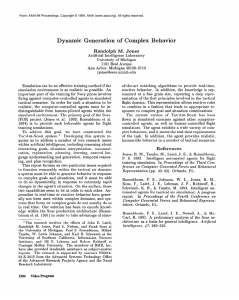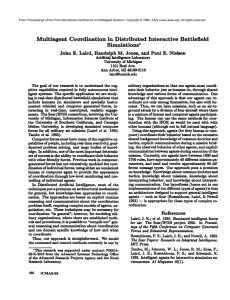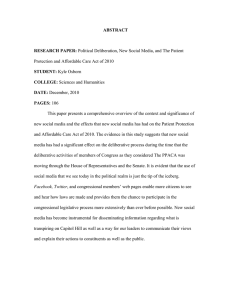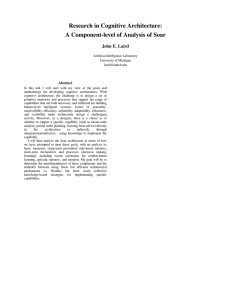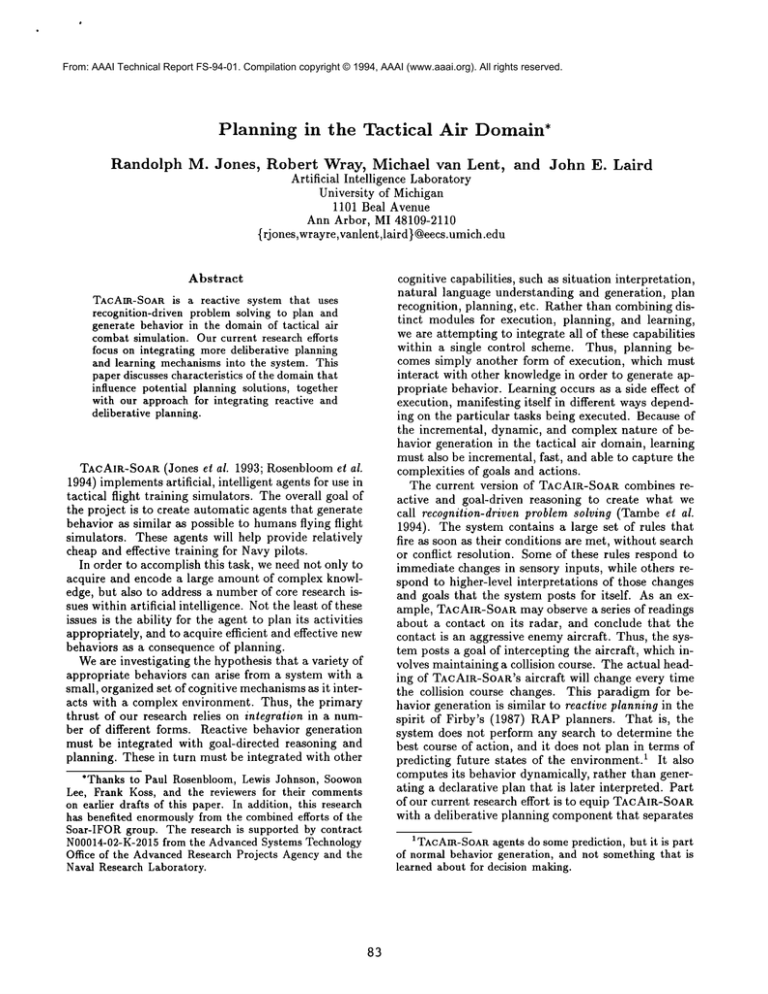
From: AAAI Technical Report FS-94-01. Compilation copyright © 1994, AAAI (www.aaai.org). All rights reserved.
Planning in the Tactical
Randolph
M. Jones,
Air Domain*
Robert
Wray, Michael
van Lent,
Artificial Intelligence Laboratory
University of Michigan
1101 Beal Avenue
Ann Arbor, MI 48109-2110
(rjones,wrayre,vanlent,laird}@eecs.umich.edu
Abstract
TAcAm-SoAR
is a reactive system that uses
recognition-driven problem solving to plan and
generate behavior in the domainof tactical air
combatsimulation. Our current research efforts
focus on integrating more deliberative planning
and learning mechanismsinto the system. This
paper discusses characteristics of the domainthat
influence potential planning solutions, together
with our approach for integrating reactive and
deliberative planning.
TACAIR-SOAR
(Jones el al. 1993; Rosenbloomet al.
1994) implementsartificial, intelligent agents for use in
tactical flight training simulators. The overall goal of
the project is to create automatic agents that generate
behavior as similar as possible to humansflying flight
simulators. These agents will help provide relatively
cheap and effective training for Navypilots.
In order to accomplish this task, we need not only to
acquire and encode a large amount of complex knowledge, but also to address a numberof core research issues within artificial intelligence. Not the least of these
issues is the ability for the agent to plan its activities
appropriately, and to acquire efficient and effective new
behaviors as a consequence of planning.
Weare investigating the hypothesis that a variety of
appropriate behaviors can arise from a system with a
small, organized set of cognitive mechanismsas it interacts with a complex environment. Thus, the primary
thrust of our research relies on integration in a number of different forms. Reactive behavior generation
must be integrated with goal-directed reasoning and
planning. These in turn must be integrated with other
*Thanks to Paul Rosenbloom, Lewis Johnson, Soowon
Lee, Frank Koss, and the reviewers for their comments
on earlier drafts of this paper. In addition, this research
has benefited enormouslyfrom the combinedefforts of the
Soar-IFORgroup. The research is supported by contract
N00014-02-K-2015from the AdvancedSystems Technology
Office of the AdvancedResearch Projects Agencyand the
Naval Research Laboratory.
and
John
E.
Laird
cognitive capabilities, such as situation interpretation,
natural language understanding and generation, plan
recognition, planning, etc. Rather than combining distinct modules for execution, planning, and learning,
we are attempting to integrate all of these capabilities
within a single control scheme. Thus, planning becomes simply another form of execution, which must
interact with other knowledgein order to generate appropriate behavior. Learning occurs as a side effect of
execution, manifesting itself in different ways depending on the particular tasks being executed. Because of
the incremental, dynamic, and complex nature of behavior generation in the tactical air domain, learning
must also be incremental, fast, and able to capture the
complexities of goals and actions.
The current version of TACAIR-SOAR
combines reactive and goal-driven reasoning to create what we
call recognition-driven problem solving (Tambeet al.
1994). The system contains a large set of rules that
fire as soon as their conditions are met, without search
or conflict resolution. Someof these rules respond to
immediate changes in sensory inputs, while others respond to higher-level interpretations of those changes
and goals that the system posts for itself. As an example, TAcAIR-SOAR
may observe a series of readings
about a contact on its radar, and conclude that the
contact is an aggressive enemyaircraft. Thus, the system posts a goal of intercepting the aircraft, which involves maintaining a collision course. The actual heading of TAcAIR-SOAR’s
aircraft will change every time
the collision course changes. This paradigm for behavior generation is similar to reactive planning in the
spirit of Firby’s (1987) RAPplanners. That is, the
system does not perform any search to determine the
best course of action, and it does not plan in terms of
predicting future states of the environment. 1 It also
computes its behavior dynamically, rather than generating a declarative plan that is later interpreted. Part
of our current research effort is to equip TACAIIt-SOAR
with a deliberative planning componentthat separates
1TAcAIR-SoAR
agents do someprediction, but it is part
of normal behavior generation, and not something that is
learned about for decision making.
planning from normal execution by projecting future
possible states and searching through them to decide
on appropriate courses of action.
Of the following three sections, the first provides a
short motivation for the usefulness of deliberative planning in the tactical air domain. The second lists a
number of characteristics
of the domain that have a
significant impact on how planning must occur. These
characteristics have been discussed in various earlier
work on planning, but our work will address all of
them together and attempt to provide a planning solution that naturally integrates into recognition-driven
problem solving. The final section sketches potential
solutions for deliberative planning. These solutions are
suggested by a combinationof the characteristics of the
domain, our desire for a fully integrated system, and
the problem-solving and learning paradigms provided
by the Soar architecture.
their actions after a scenario, and consider some hypothetical alternatives. The deliberative planning mechanism should expand on this approach and allow the
system to learn from the debriefing experience. In addition, we intend the same planning mechanism to be
used for planning both in the dynamic environment of
an engagement and the calm, slow-paced environment
of a debriefing session. Naturally, when the agent has
more time to plan, the quality and quantity of effective
learning should increase, but this will be due to the dynamics of the planning situation, not because of any
differences in the planning and learning mechanisms.
Planning Issues for Tactical Flight
This section focuses on the specific aspects of the tactical air domain that have a significant impact on how
planning should be carried out. There are five particular characteristics that set the domain apart from
traditional domains used in planning research.
Advantages
of Deliberative
Planning
As mentioned previously, the overall goal for the
TACAIR-SOAR
system is to generate human-like behavior within the simulated environment. One hallmark of humanbehavior is flexibility in the face of
new situations. The current system has been equipped
with a large knowledgebase of tactics, vehicle dynamics, weaponscharacteristics, etc., and this allows the
system to generate a wide variety of behaviors in response to different situations, missions, and goals. One
approach to this type of domain has been to attempt to
capture every possible situation that an agent mayencounter in a recognition rule (e.g., BimsoneL al. 1994).
However,even if such an approach is possible, it would
require extensive work on the knowledge base every
time the domain changes a bit (for example, if new
aircraft or missiles are developed).
In response to this difficulty, an agent must detect
when it does not have suitable knowledgeto react to a
particular situation, and use its planning capabilities to
generate appropriate actions based on more fundamental knowledge. This requires the agent to integrate deliberative planning with its current recognition-driven
reasoning mechanisms. Naturally, we also expect the
agent to learn from its planning episodes, generating
new rules for future similar situations.
TACAIR-SOAR
will do much of its planning "in the
air," where there are tight restrictions on time, thus
limiting the learning opportunities. However, human
pilots often learn by flying real or simulated scenarios, and then debriefing the scenarios on the ground.
By going back over each step of the scenario, the pilot can identify successes and failures, consider alternative courses of action, and take more time to evaluate various possible outcomes. Automated agents
have also been demonstrated to benefit from such selfexplanations (VanLehn, Jones, & Chi 1992). In addition, Johnson (1994a; 1994b) has presented a debriefing facility, in which TACAIR-SOAR
agents can explain
Interaction of DomainGoals
The current version of TAcAIR-SoAttknows about almost 100 different types of goals, and manyof these
interact with each other. For example, there are times
when an agent wants simultaneously to fly toward a
target, evade an incoming missile, and maintain radar
contact with another aircraft. This presents the traditional problem of planning for goal conjuncts (Chapman 1987; Covrigaru 1992). However, we must trade
off the intensive search that can be involved in this
type of planning with the dynamic and uncertain nature of the task (discussed below). Other researchers
(e.g., Cohen el al. 1989; Veloso 1989) have suggested
methods for planning about conjunctive goals in real
time, and we hope to borrow from these approaches in
our ownefforts.
Two primary elements of conjunctive goal planning
are detecting a goal interaction and then finding a way
to deal with the interaction.
Within TACAm-SOAR,
interactions will generally be detected when conflicting output commandsare sent to the simulator (e.g.,
to come to two different headings) or when goal constraints are incompatible (e.g., turning away from
target while also maintaining a radar lock). In general,
there will be two methods for dealing with such goal
interactions. Somegoals can be achieved conjunctively
(perhaps not as efficiently as if the goals were independent), but sometimes it will be necessary to suspend
certain goals temporarily when goals of higher priority (such as evading an incoming threat) conflict with
them.
Dynamic,
Real-Time
Environment
As suggested above, TACAIR-SOAR
cannot generally
assume that it has ample time to plan. An agent may
be planning an intercept course to a target when it
detects an incoming missile. In this case, the agent
must interrupt its planning in order to react in a timely
84
fashion. As a slightly different case, the situation may
change so rapidly that the conditions that initiated
planning may become obsolete before planning is completed. For example, the agent may begin planning
which type of weapon it should employ against a target, only to find it destroyed by some other participant in the engagement. In both of these situations,
the system should cease its planning activity, even if it
did not find a result. Reactive planning systems (e.g.,
Agre & Chapman 1987; Firby 1987; Kaelbling 1986),
and TAcAm-SoAR’s
recognition-driven
problem solving address some of these issues by dynamically changing goals and behaviors as the environment changes.
The next challenge is to integrate deliberative planning with dynamic reasoning in a smooth way.
Large State Representation
A further characteristic of the domain is that it involves rather large representations of the agent’s current situation. The state representation includes information about various vehicle and weapon types, sensor information (from visual, radar, and radio sources),
the agent’s current mission goals, other "mental" annotations, and interpretations of the state, actions,
and goals of other agents. For normal recognitiondriven problem solving, the situated TAcAm-SoAR
agent simply reacts to various features in this large
state by generating actions or posting new goals or
newinterpretations of the situation.
The size of the state can impact deliberative planning in three ways. First, any time the agent wishes to
plan, it must construct a copy of its current state representation. It can then manipulate this copy without
changing its actual representation of the world or issuing real behaviors. Second, separating the two state
representations allows the system to generate low-level
reactions in response to one state while planning with
the other. Because it takes some time to create this
mental planning state, the agent should copy only the
necessary information for planning and no more. Finally, someof the state information will be important
to the current plan, while other information will be less
important or totally irrelevant. It is not desirable for
the agent to reason about portions of the state that
have no bearing on the current decision. Thus, decisions about how muchstate to copy will have an impact
on learning and the generality of new behaviors.
Planning in the Face of Uncertainty
A key feature of the tactical air domainis that there is
generally a large number of participants in any given
scenario. Someresearch (e.g., Georgeff 1984) has focused on this problem, and it naturally will have a
strong effect on how TAcAm-SoAR
can interpret and
predict the consequences of its actions while planning. Anticipating the actions of cooperating agents
may not be too difficult,
because there exist social
engagements and standard operating procedures be-
tween agents that cooperate. Predicting the future
actions of competing agents is somewhat more difficult, and relies in part on recognizing the plans and
goals of those agents (Tambe & Rosenbloom 1994;
Wilensky 1981).
Given the unpredictable nature of modeling other
agents, it is most appropriate for TAcAm-SoAR
to
create completable plans (Gervasio & DeJong 1994),
in order to react appropriately to future actions by
other agents. Contingency plans (Warren 1976) might
also be useful, but these are generally expensive to
generate. In a sense, TAcAIR-SOAR’s
current knowledge base consists of a large completable plan, and
such planning is consistent with our desire to integrate
the current recognition-driven problem-solving structure with deliberative planning. The results of deliberative planning should be completable, reactive plans
that the agent can execute and adapt in response to
the dynamics of the environment.
Termination
of Planning
As we have already mentioned, available time will have
a large impact on how long any planning activity can
continue. However,termination of planning is also influenced by when results can be produced. Most traditional planners have small sets of explicit, well-defined
goals, and a precise evaluation function, so they can
plan until a method is found to achieve their goals.
Within the tactical air domain, there are manydifferent types of goals, and different degrees to which they
can be achieved. As an example, if an aircraft has the
mission to protect its aircraft carrier, it may produce
the goal of destroying an incoming attack aircraft. After the engagement has proceeded, the agent may find
itself drifting from the carrier it is supposedto protect.
At this point, it may decide that it has completed its
mission by "scaring off" the threat, without actually
destroying it, and it would be more dangerous to continue than to return to its patrol position.
The combination of limited reasoning time and illdefined goals provides a further complexity for planning. The question is how far the planning process should continue, and when evaluation should take
place.
Solutions
for
Deliberative
Planning
These characteristics all have an impact on how planning can occur in an intelligent agent. Manyof these
issues have been addressed to some extent in previous
research, but we hope to build an integrated system
that addresses all of them. This section describes our
preliminary efforts to develop an integrated planning
solution that addresses all of the complexities of the
domain. It begins with a discussion of the overall integrated framework, and then describes specific ideas
for each of the planning issues.
85
Integrated
Planning,
Learning,
and
Execution
Our commitment to an integrated system began with
our selection of the Soar architecture (Laird, Newell,
& Rosenbloom 1987) as the platform for development. Soar provides an ideal basis for recognitiondriven problem solving, and naturally supports the integration of execution, planning, and learning (Laird
& Rosenbloom 1990).
Readers familiar with Soar will recall that all reasoning and behavior generation takes place in problem
spaces, through the deliberate selection of operators. A
fair amount of research on traditional planning within
Soar (e.g., Lee 1994; Rosenbloom,Lee, &: Unruh 1992)
also organizes planning knowledge as sets of problem
spaces. Problem spaces are collections of knowledge
that address subgoals, which arise in response to a lack
of knowledgein a particular situation. A typical example for planning occurs when an agent has a number of
candidate actions to take, but does not have the knowledge to decide between them. For example, a pilot
must decide which type of weapon to employ against
a target, given the current mission and circumstances
of the environment. After planning knowledge (e.g.,
a mental simulation of the alternatives) suggests an
ordering, the automatic learning mechanism summarizes search in the problem space into individual rules
("chunks") that will apply in future similar situations.
Weshould stress the point that the natural representation for a plan within TACAIR-SOAR
is not a
declarative script of actions. Rather, a plan is a collection of recognition-driven rules and operators that
apply opportunistically in response to particular patterns of sensor values, interpretations, and goals. Thus,
in a sense, TACAIR-SOAR
will never be learning entire
plans, but it will be repairing or completing the general
plan composedof all of its recognition rules.
Addressing
Domain Issues
This integrated frameworksuggests possible solutions
for planning that also address the issues presented earlier. To begin with, the high degree of interaction between goals suggests criteria for both triggering and
evaluating new plans. Previously, we suggested that
planning occurs when TAcAm-SoARdoes not have
the reactive knowledge necessary to choose between
competing actions. This can be generalized to initiating planning any time the system detects an interaction between goals that it does not know how to handle. Covrigaru (1992) and Lee (1994) have investigated
planning methods within Soar to address interactions
between different types of goals. Evaluation of potential plans will be based on the resolution of individual
interactions--as opposed to, for example, planning exhaustively until all interactions are resolved. As the
agent develops responses to individual interactions, it
can learn partial planning results in the form of new
recognition rules.
86
These partial results also address the dynamic characteristics
of the domain. Such planning will integrate smoothly with normal behavior generation because every planning episode will cause the system
to learn something. If it is not something that completely resolves the current situation, it should at least
allow the planning process to resume later without having to start over. Thus, particular planning efforts
can be temporarily suspended (or perhaps abandoned
entirely) without having been a total waste of time.
Whenthe system has ample time to plan (such as in
debriefing session), it is not clear whether the planning
process will need to be qualitatively different. Presumably, the system will still be able to use its incremental
planning techniques, but generate better quality plans
because it has more time to evaluate and resolve interactions.
Also in response to to the dynamic domain, our
initial efforts with TACAIR-SOAR
have addressed the
issue of integrating planning with execution. Many
of the system’s actions can apply without regard for
whether the system is currently planning. For any aspects of the current situation that do not depend on
the current planning activity, the system continues to
generate behavior independent of other processing.
Because of TACAIR-SOAR’s
large state representation, we have adopted high-level, qualitative descriptions that summarize direct sensor readings, thereby
reducing the amount of information that must be
copied. In addition, the system attempts to make intelligent decisions about the portions of the state it cares
about. These decisions are based on a static analysis
of the domain knowledge, as well as dynamic reasoning
based on the current situation. This allows the system
to limit the amountof work it does in creating a mental
copy of the state, which has been our primary concern
in preliminary work on planning.
Our hope is that this approach will also aid the system in reasoning in an uncertain environment. As we
have discussed, an appropriate response to this issue
is to generate completable plans. In TACAm-SOAR’s
terms, we wish to learn new rules for posting general
goals, allowing the specific situation at execution time
to dictate the precise actions that should be taken to
satisfy those goals. Thus, a further aim for setting up
a mental state for planning is to abstract away details
that can be filled in by the situation later.
Finally, the criteria for terminating the planning process arise in part from the solutions we have already
discussed. If there is time to plan exhaustively, the
system will generate solutions for all the goal interactions it detects. Because the system returns incremental results as it plans, it is not as important for
it to determine a fixed stopping criterion. If planning
must be suspended temporarily, the partial planning
results should allow planning to resume from where
it left off. Finally, as we have mentioned, the system
is able to generate behavior simultaneously with plan-
ning in manysituations, so planning will not have to
be interrupted until it is actually finished.
Johnson, W. L. 1994b. Agents that learn to explain
themselves. In Proceedings of AAAI-g4, 1257-1263.
Menlo Park, CA: AAAIPress.
Jones, R. M.; Tambe, M.; Laird, J. E.; and Rosenbloom, P. S. 1993. Intelligent automated agents for
flight training simulators. In Proceedings of the Third
Conference on Computer Generated Forces and Behavioral Representation, 33-42.
Kaelbling, L. P. 1986. An architecture for intelligent
reactive systems. In Proceedings of the Workshopon
Planning and Reasoning about Action, 235-250.
Laird, J. E., and Rosenbloom,P. S. 1990. Integrating
execution, planning, and learning in Soar for external
environments. In Proceedings of AAAI-90, 1022-1029.
Menlo Park, CA: AAAIPress.
Laird, J. E.; Newell, A.; and Rosenbloom,P. S. 1987.
Soar: An architecture for general intelligence. Artificial Intelligence 33:1-64.
Lee, S. 1994. Multi-Method Planning. Ph.D. Dissertation, Department of Computer Science, University
of Southern California.
Rosenbloom, P. S.; Johnson, W. L.; Jones, R. M.;
Koss, F.; Laird, J. E.; Lehman, J. F.; Rubinoff, R.;
Schwamb,K. B.; and Tambe, M. 1994. Intelligent automated agents for tactical air simulation: A progress
report. In Proceedings of the Fourth Conference on
Computer Generated Forces and Behavioral Representation, 69-78.
Rosenbloom, P. S.; Lee, S.; and Unruh, A. 1992. Bias
in planning and explanation-based learning. In Chipman, S., and Meyrowitz, A., eds., Machine Learning: Induction, analogy and discovery. Norwell, MA:
Kluwer.
Tambe, M., and Rosenbloom, P. S. 1994. Event tracking in complex multi-agent environments. In Proceedings of the Fourth Conference on Computer Generated Forces and Behavioral Representation, 473-484.
Tambe, M.; Jones, R. M.; Laird, J. E.; Rosenbloom,
P. S.; Schwamb, K.; and Koss, F. 1994. Intelligent agents for interactive simulation environments.
Manuscript in preparation.
VanLehn, K.; Jones, R. M.; and Chi, M. T. H. 1992.
A model of the self-explanation effect. Journal of the
Learning Sciences 2:1-59.
Veloso, M. M. 1989. Nonlinear problem solving
using intelligent
casual commitment. Technical Report CMU-CS-89-210, School of Computer Science,
Carnegie Mellon University, Pittsburgh, PA.
Warren, D. H. D. 1976. Generating conditional plans
and programs. In Proceedings of the AISB Conference, 344-354.
Wilensky, R. 1981. Inside computer understanding: Five programs plus miniatures. Hillsdale, NJ:
Lawrence Erlbaum.
Summary
Simulated tactical air combat is an ideal, real domain
for developing and testing new planning methods. The
complexities of the task require us to focus on a number of planning issues that can be safely ignored in
traditional planning domains. Although many of these
issues have been addressed to some extent in the planning literature, we plan to provide an integrated solution to all of them. Wehave begun creating a system that smoothly integrates reactive and deliberative
planning within the recognition-driven problem solving
framework. Although our efforts with the deliberative
planning componentare young, our initial experiences
have been encouraging. Hopefully, the complexities
and real-time demands of the tactical air domain will
lead us to a system that can model a continuum of
planning processes from purely reactive to knowledge
intensive and deliberate.
References
Agre, P. E., and Chapman, D. 1987. Pengi: An
implementation of a theory of action. In Proceedings
of AAAI-87, 123-154. Menlo Park, CA: AAAIPress.
Bimson, K.; Marsden, C.; McKenzie, F.; and Paz,
N. 1994. Knowledge-based tactical
decision making in the CCTTSAF prototype. In Proceedings of
the Fourth Conference on Computer Generated Forces
and Behavioral Representation, 293-303.
Chapman, D. 1987. Planning for conjunctive goals.
Artificial Intelligence 32:333-377.
Cohen, P. R.; Greenberg, M. L.; Hart, D. M.; and
Howe, A. E. 1989. Understanding the design requirements for agents in complex environments. AI Magazine 10(3):32-48.
Covrigaru, A. 1992. Emergence of meta-level control in multi-tasking autonomousagents. Ph.D. Dissertation, Department of Electrical Engineering and
Computer Science, University of Michigan.
Firby, R. J. 1987. An investigation into reactive planning in complex domains. In Proceedings of AAAI-87,
202-206. Menlo Park, CA: AAAIPress.
Georgeff, M. 1984. A theory of action for multiagent
planning. In Proceedings of AAA1-84, 121-125. Menlo
Park, CA: AAAIPress.
Gervasio, M. T., and DeJong, G. F. 1994. An incremental learning approach for completable planning.
In Machine Learning: Proceedings of the Eleventh National Conference, 78-86. San Francisco, CA: Morgan
Kaufmann.
Johnson, W. L. 1994a. Agents that explain their
ownactions. In Proceedings of the Fourth Conference
on Computer Generated Forces and Behavioral Representation, 87-95.
87

